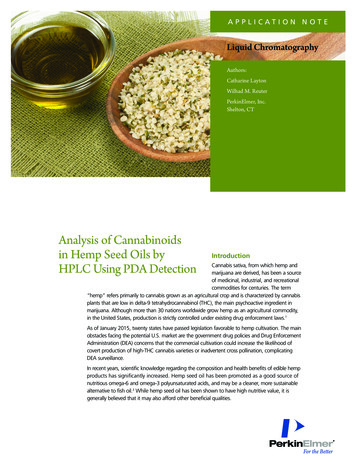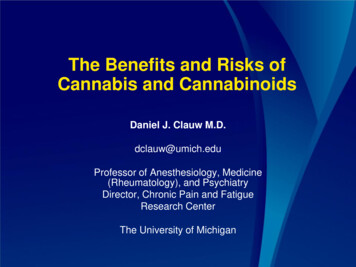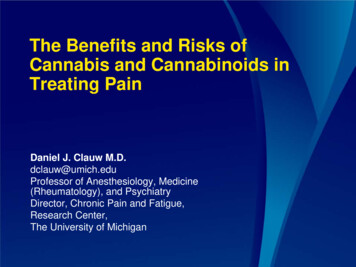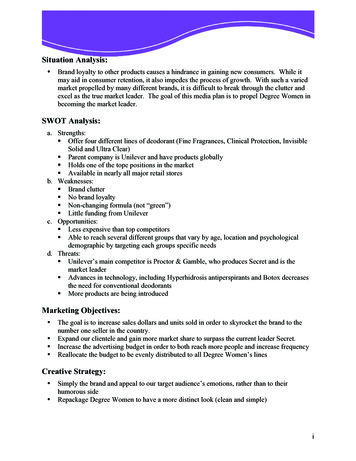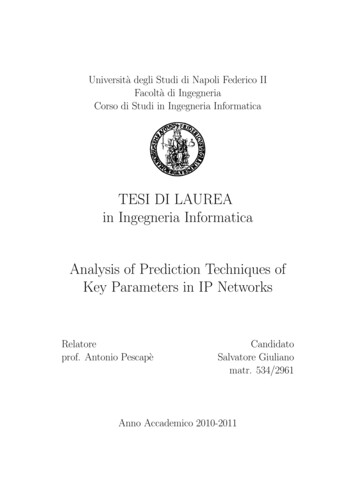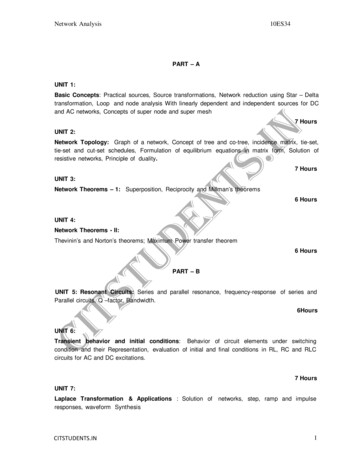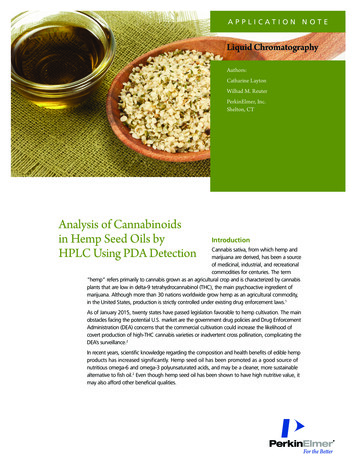
Transcription
A P P L I C AT I O N N O T ELiquid ChromatographyAuthors:Catharine LaytonWilhad M. ReuterPerkinElmer, Inc.Shelton, CTAnalysis of Cannabinoidsin Hemp Seed Oils byHPLC Using PDA DetectionIntroductionCannabis sativa, from which hemp andmarijuana are derived, has been a sourceof medicinal, industrial, and recreationalcommodities for centuries. The term“hemp” refers primarily to cannabis grown as an agricultural crop and is characterized by cannabisplants that are low in delta-9 tetrahydrocannabinol (THC), the main psychoactive ingredient ofmarijuana. Although more than 30 nations worldwide grow hemp as an agricultural commodity,in the United States, production is strictly controlled under existing drug enforcement laws.1As of January 2015, twenty states have passed legislation favorable to hemp cultivation. The mainobstacles facing the potential U.S. market are the government drug policies and Drug EnforcementAdministration (DEA) concerns that the commercial cultivation could increase the likelihood ofcovert production of high-THC cannabis varieties or inadvertent cross pollination, complicating theDEA’s surveillance.2In recent years, scientific knowledge regarding the composition and health benefits of edible hempproducts has increased significantly. Hemp seed oil has been promoted as a good source ofnutritious omega-6 and omega-3 polyunsaturated acids, and may be a cleaner, more sustainablealternative to fish oil.2 Even though hemp seed oil has been shown to have high nutritive value, itmay also afford other beneficial qualities.
Naturally occurring cannabinoids, the main biologically activecomponent of the cannabis plant, form a complex group ofclosely related compounds, of which 70 are known and welldescribed. Although no cannabinoids are metabolically producedby the hemp seed itself, contamination with resin from cannabisflowers and leaves during hemp seed oil processing can occur.Impurity reports have been primarily focused on THC for itspharmacological and toxicological relevance, upon which strictlegal limits have been enforced.4 But other cannabinoidsprovide unique biological activities. For example, cannabidiol(CBD), typically present at higher levels than THC, showsevidence of providing anticonvulsive, anti-epileptic, andantimicrobial properties.2,3,4In this application, we describe a technique for the monitoringof six cannabinoids, including THC and CBD, in hemp seed oil byHPLC combined with PDA detection. Figure 1 shows the chemicalstructures for the six cannabinoids analyzed in this application.ExperimentalHardware/SoftwareA PerkinElmer Altus HPLC system was used, including theA-10 Solvent/Sample Module, A-10 column heater andA-10 UV detector (PerkinElmer, Shelton, CT, USA). An A-10PDA (photodiode array) detector was also used for spectralconfirmation. A PerkinElmer Brownlee SPP C18, 2.7 µm,3.0 x 100-mm column was used for all analyses (PerkinElmer,Shelton, CT, USA). All instrument control, analysis, anddata processing was performed via Waters Empower 3Chromatography Data Software (CDS).Method ParametersThe LC method parameters are shown in Table 1.Solvent A: 0.1% formic acid in waterSolvent B: 0.1% formic acid in acetonitrileSolvent program:Mobile Phase:Analysis Time:Flow Rate:Pressure:Oven Temp.:PDA Detection:Injection Volume:Sampling (Data) Rate:Diluent:Sampling (Data) Rate:1Time(min)Flow 1.11.020.080.048.11.05.095.058.61.050.050.08.0 min.; wash/equilibration time 7.0 min.1.0 mL/min. 2500 psi/172 bar maximum50 ºCWavelength: 210 nm25 µL10 pts./secIsopropyl alcohol (IPA)5 pts./secSolvents, Standards and SamplesAll solvents and diluents used were HPLC-grade and filtered via0.45-µm filters.1 mg/ml each of the following cannabinoids was obtained fromRestek Corporation (Bellefonte, PA): cannabidiol (CBD),cannabigerol (CBG), cannabinol (CBN), cannabichromene (CBC)and tetrahydrocannabinolic acid (THC-A). 1 mg/mL of delta-9tetrahydrocannabinol (THC) was obtained from Sigma-Aldrich ,Inc (Allentown, PA).A 14-ppm mixture of the six standards was prepared by adding25 µL of each standard to 1.650 mL of isopropyl alcohol (IPA).For hemp seed oil quantitation, a standard solution containing THCand CBD was prepared by adding 25.0 µL of each into 1.750 mLDelta-9 tetrahydrocannabinol (THC)Cannabidiol (CBD)Cannabigerol (CBG)Cannabinol (CBN)Cannabichromene (CBC)Tetrahydrocannabinolic acid (THC-A)Figure 1. Chemical structure of six cannabinoids analyzed in this study.2Table 1. LC Method Parameters.PerkinElmer Brownlee Analytical C18, 3.0 µm, 4.6 x 150-mmColumn:(Part# N9303508)
of IPA, to equal a final concentration of 14 ppm.Results and DiscussionTwo brands of hemp seed oils were obtained from a local healthfood store. In order to reduce the viscosity of the hemp seed oilprior to analysis, each sample was diluted nine fold in IPA byadding 0.2 mL hemp seed oil to 1.6 mL of IPA and mixing bymanual shaking. A 14-ppm spiked solution of each hemp seed oilsample was prepared by adding 25.0 µL THC standard, 25.0 µLCBD standard, 0.2 mL hemp seed oil, and 1.55 mL IPA to a 2-mLsample vial and then mixed by hand shaking. Considering thenine fold dilution of sample, the final cannabinoid concentrationcorresponded to 125-ppm in undiluted hemp seed oil.Figure 2 shows the chromatogram of a standard mixture containingthe six cannabinoids, all separated in under eight minutes.As shown in Figure 3, chromatographic repeatability wasconfirmed via 10 injections of the 14-ppm standard mixture,demonstrating good hromene (CBC)THC-A1.10Cannabinol (CBN)Cannabigerol (CBG)Cannabidiol 2.00MinutesFigure 2. HPLC chromatogram showing separation of six cannabinoids in the 14-ppm standard mixture; wavelength: 210 509.00MinutesFigure 3. Overlay of 10 replicates of the 14-ppm standard mixture.3
Linearity was determined for all six cannabinoids. Representativelinearity plots for CBD and THC, respectively, are shown in Figure 4and Figure 5. The linearity coefficients of determination for all sixcannabinoids are listed in Table 2.Table 2. Linearity coefficient of determination for six cannabinoids between 1 –14 ppmdetected by PDA at 210 nm.AflatoxinCBD2.5x10 62.0x10 60.99951Cannabidiol (CBD)Cannabinol (CBN)Delta-9 tetrahydrocannabinol (THC)Cannabichromene (CBC)Delta-9-tetrahydrocannabinolic acid (THC-A)0.999940.999960.999250.999580.99857As listed in Table 3, LOD (limit of detection) and LOQ (limit ofquantitation) levels were established for each cannabinoid, basedupon undiluted hemp seed oil and a s/n of 3/1 for LOD and 10/1 for LOQ. The LOD and LOQ values were less than 200 ppband 600 ppb, respectively, for all cannabinoids.1.5x10 6AreaLinearity R2Cannabigerol (CBG)1.0x10 65.0x10 50.0Table 3. LOQ and LOD of six cannabinoids in undiluted Hemp Seed Oil.R2 0.99994-5.0x10 50.002.004.006.008.0010.0012.0014.00Figure 4. Linearity plot of CBD; concentration range: 1-14 ppm in IPA.4.0x10 6THC3.5x10 6LOD via PDA(ppb)LOQ via PDA(ppb)Cannabigerol (CBG)31102Cannabidiol (CBD)Cannabinol (CBN)Delta-9-tetrahydrocannabinol (THC)Cannabichromene (CBC)Delta-9-tetrahydrocannabinolic acid x10 62.5x10 6Figures 6 and 7 show the chromatograms of Brand 1 and Brand 2un-spiked hemp seed oils, respectively, overlaid with standard mix.CBD was present in both of the un-spiked hemp seed oils, elutingat approximately 4.9 minutes and confirmed by PDA detection(data not shown). THC was detected at very low levels (belowLOQ) in both samples, while the other five analytes were notdetected in either of the analyzed oils.Area2.0x10 61.5x10 61.0x10 65.0x10 50.0R2 0.99917-5.0x10 50.002.004.006.008.0010.0012.0014.00For comparison, an overlay of THC/CBD-spiked and un-spikedBrand 2 hemp seed oil is shown in Figure 8.ppmFigure 5. Linearity plot of THC; concentration range: 1-14 ppm in IPA.1.40AU0.800.70THC-A0.90Cannabichromene (CBC)1.00THC1.10Cannabinol (CBN)1.20Cannabidiol (CBD)Cannabigerol .506.006.50MINUTESFigure 6. Overlay of a mixture of six cannabinoids (blue) and Brand 1 of the un-spiked hemp seed oil (black).47.007.508.008.50
1.40AU0.800.700.60THC-A0.90Cannabichromene (CBC)1.00THC1.10Cannabinol (CBN)1.20Cannabidiol (CBD)Cannabigerol re 7. Overlay of a mixture of six cannabinoids (blue) and Brand 2 of the un-spiked hemp seed oil (black).1.401.201.101.000.90THCCannabidiol 04.505.005.506.00MINUTES6.50Figure 8. Overlaid chromatograms of a blank (red), Brand 2 un-spiked hemp seed oil (black) and Brand 2 hemp seed oil spiked with 125-ppm THC and CBD (blue).The recovery of the spiked THC and CBD analytes was between91-110%, as shown in Table 4. As CBD was observed in bothbrands of the un-spiked hemp seed oil, the recovery of spiked CBDwas calculated by subtracting the un-spiked CBD concentrationfrom the overall recovery.Table 4. Recovery results for hemp seed oil spiked with THC and CBD at 125 ppm (n 2).Hemp Seed OilCBD (%)THC (%)Brand A spiked91.096.6Brand B spiked95.6110.25
ConclusionReferencesThis work has demonstrated the effective chromatographicseparation and quantitation of six cannabinoids, including THC andCBD, in hemp seed oils using the PerkinElmer Altus HPLC Systemwith A-10 UV detector. The results exhibited exceptional linearity foreach of the six cannabinoids over the tested concentration range.1. Johnson, Renee. “Hemp as an Agricultural Commodity:Congressional Research Service”, CRS Report, 2015.2. Hazekamp, Arno. “Cannabis Review”, Department ofPlant Metobolomics, Leiden University. 2008-2009.3. Leizer, Cary et.al. “The Composition of Hemp Seed Oil andIts Potential as an Important Source of Nutrition. 2000.4. “Cannabis oil vs hemp seed oil; Cannabis oil, CDB Oil,Medical Marijuana”. http://cbd.org/cannabis oil-vs-hemp-oil.PerkinElmer, Inc.940 Winter StreetWaltham, MA 02451 USAP: (800) 762-4000 or( 1) 203-925-4602www.perkinelmer.comFor a complete listing of our global offices, visit www.perkinelmer.com/ContactUsCopyright 2015, PerkinElmer, Inc. All rights reserved. PerkinElmer is a registered trademark of PerkinElmer, Inc. All other trademarks are the property of their respective owners.012317 01PKI
nutritious omega-6 and omega-3 polyunsaturated acids, and may be a cleaner, more sustainable alternative to fish oil.2 Even though hemp seed oil has been shown to have high nutritive value, it may also afford other beneficial qualities. Analysis of Cannabinoids in He
